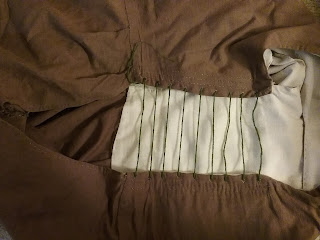A question on the
Sewing Academy forum prompted this little research project. Mrs. Watkins was trying to decide whether her new sleeves should be elbow-length or longer. I decided that this was an excellent excuse for too!much!math!, because I like using statistical analysis to understand trends of 19th century dress. Also, it makes me look really closely and systematically at a large sample of original garments, which is always fun and edifying.
The spreadsheet is
here. The amount of information available on each item varies; the percentages of each sleeve and decoration type reflect this.
Basic Summary: Of the 93 sets of sleeves, 80.6% had fabric as their base material; these were mostly very fine cottons, with 12/75 (16%) of the fabric sleeves identified as linen. Net was the base material of 16.1% of sleeves, and lace for 3.2%.
Embroidery was the most common adornment (49.5%), with cut work embroidery (including broderie anglaise) accounting for a further 15.1% of the sleeves; all told, 64.6% of the sleeves had some sort of embroidery. Just over 1/3 (34.4%) had lace or net present, aside from the main fabric of the piece. Self-fabric elements, such as tucks or puffs, appears in 19.4% of the sleeves, and 9.7% had ribbon. Six (6.4%) had no decorative features, while four lacked information.
Most (59.1%) of the sleeves were closed at the wrist; 12.9% were open at the wrist; 24.7% were open at the wrist, but set close further up (often with a band near the forearm and a flounce below). The remainder lacked information.
The most common top finish was a narrow hem (43%), though this may include narrow casings that have lost their drawstring or elastic; a third (33.3%) finished with a wider band at the top, often with this band fitted smooth and the full sleeve gathered into it; 15.1% had drawstrings or elastic present; one sleeve had a band with buttoned to itself along the upper edge.
Measurements were not available for most of the sleeves (see below). For those that were, the average length was 17.4", with a minimum length of 9", a maximum of 22", and a mode of 19".
Parameters: I included extent undersleeves from museum online collections, with dates listed in the 1850s and/or 1860s, as well as those labelled “Mid 19th century”, and “3rd Quarter 19th century.” This potentially includes pieces from the 1840s to c.1875, but generally concentrates on 1850s and 1860s. I did not include sleeves only labelled as “19th century” or “second half of 19th century,” even when they resembled pieces dated in the target time period (and the Museum of Fine Arts Boston has some lovely examples, if you want eye-candy). One sleeve each from Nancy Bradfield's
Costume in Detail, and Janet Arnold's
Patterns of Fashion 1 and
Patterns of Fashion 2 were included. I may add to this in the future.
I used decimals for spreadsheet ease, though measurements were listed in fractions of inches; I also rounded to the nearest 1/8", with proportions rounded to nearest ¼"; where needed measurements were not given, but could be inferred from the proportions in the picture, those proportions/inferences are given in bold text. Since measurements are usually given as the object's maximum length and width, while I needed length, cuff and upper arm sizes, I used italics to denote measurements that are tentative (usually a width measurement applied to the widest part of a open undersleeve where the upper arm and wrist measurements are similar). All measurements and proportions are of the sleeve lying flat: so a cuff measurement of 3.5” would be approximately 7” circumference around the wrist. When no measurements were given, I took the smallest of the three (usually the cuff) as "x" and give inferred proportions off of that; for sleeves opening suddenly with a flounce, "x" is the smallest wrist/forearm measurement above the flounce. Analysis of these proportional 'measures' has not yet been done.











